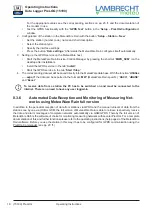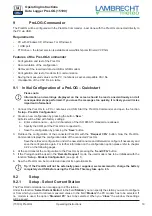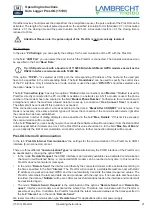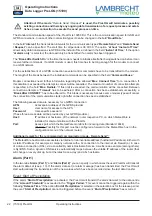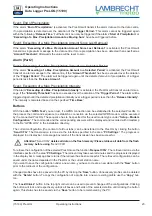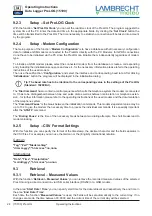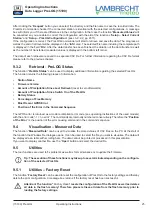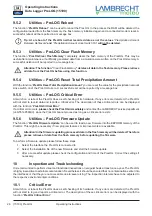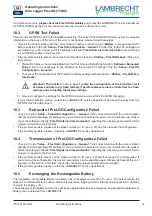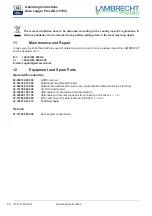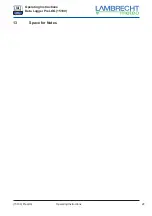
14
(15190) PreLOG
Operating Instructions
Operating Instructions
Data Logger PreLOG (15190)
Tip: Please note, that the
Precipitation Amount Since Last Retrieval
will be transmitted in the alarm
data and reset after any other alarm, too.
Also keep in mind, that the
Precipitation Amount Since Last Retrieval
will be reset to zero after
retrieval of the
PreLOG Status
.
Confi guration
The alarm “
Exceeding of a Max. Precipitation Amount Since Last Retrieval
” can be activated in the PreLOG-
Commander in the tab “
Setup – PreLOG Con
fi
guration – Alarm (Part 1)
.” Furthermore the “
Amount
T
hreshold
”
can be speci
fi
ed in steps of 0.1 mm/m² between 0 and 100 mm/m².
Event: Exceeding of a Max. Precipitation Amount as Moving Sum in a Selected Period
If the event “
Exceeding of a Max. Precipitation Amount in a Selected Period
” is activated, the PreLOG transmits
an alarm message if a max. precipitation amount is exceeded in a given time interval. The event will be released
as soon as the detected precipitation amount per time interval falls below a speci
fi
ed release amount. The moving
time interval is moved every 6 s and the precipitation amount in the time interval is recalculated.
Confi guration
The alarm “
Exceeding of a Max. Precipitation Amount in a Selected Period
” can be activated in the PreLOG-
Commander in the tab “
Setup – PreLOG Con
fi
guration – Alarm (Part 2)
.” Furthermore the “
Trigger Period
” can
be speci
fi
ed in steps of 1 min between 1 and 60 min in the corresponding area as well as the “
Amount Threshold
”
and the “
Release Amount
” in steps of 0.1 mm/m² between 0 to 100 mm/m².
Event: Exceeding of a Max. Precipitation Intensity
If the event “
Exceeding of a Max. Precipitation Intensity
” is activated, the PreLOG transmits an alarm if a max.
intensity is exceeded at all times of a given period. The event will be released if the intensity falls below a speci
fi
ed
release intensity.
Confi guration
The alarm “
Exceeding of a Max. Precipitation Intensity
” can be activated in the PreLOG-Commander in the
tab “
Setup – (PreLOG) Con
fi
guration – Alarm (Part 2)
.” Furthermore the “
Time Base
” (for the calculation of
the intensity) can be speci
fi
ed in steps of 1 min in the corresponding area as well as the “
Intensity Threshold
”,
the “
Release Intensity
” (intensity has to drop below this value before another alarm can be triggered) in steps of
0.1 mm/min up to 100 mm/min and the “
Trigger Period
” in min (during which the intensity has to be above the
intensity threshold).
8.3 Data
Transmission
The PreLOG can transmit data in several ways: from communication via USB cable to a directly connected PC to
the use of mobile communications networks. For instance in the case of automatic transmission via modem to a
PC with appropriate MeteoWare software e. g. the MeteoWare Rain.
In all cases the communication is done via the 8-pin M12 connector (COM1).
For further details regarding the con
fi
guration of the data transmission see chapter 9.2.2 (pp. 20 ff.) as well as
9.2.4 (p. 24).
Remote Request (Online/PSTN/GSM/CSD)
This technology establishes a dedicated communication channel (circuit) through the network before the nodes may
communicate. Consequently the COM1 interface is permanently available. The central node can call the PreLOG
at any time and retrieve the data via landline (PSTN - Public Switched Telephone Network), or GSM network
(CSD - Circuit Switched Data). In this communication type the PreLOG does not send alarm messages.
Many telecommunication carriers are dropping support for CSD, and CSD has been superseded by packet oriented
mobile data services.
Since the COM1 and the modem are permanently activated and consume energy in this type of communication,
the CSD mode is only conditionally suitable for applications with solar power supply.
Please note the respective connecting diagram (Fig. 10, p. 8).


















